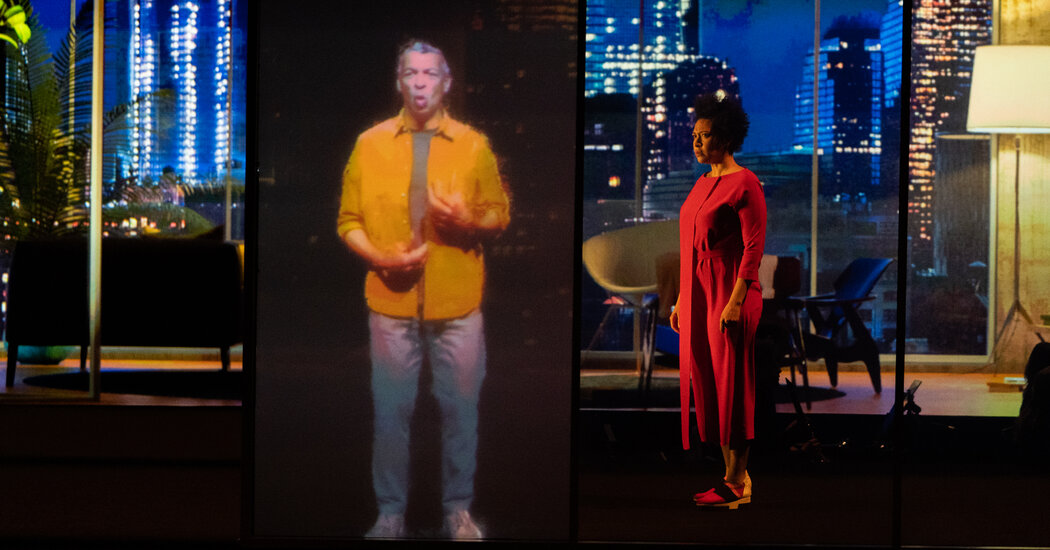Advertisement
Supported by
Critic’s Pick
Michel van der Aa’s work, a seamless interweaving of opera, film and motion-capture performance, arrives at the Park Avenue Armory.
Send any friend a story
As a subscriber, you have 10 gift articles to give each month. Anyone can read what you share.
“I am certain that you exist,” a daughter tells her father, only to reconsider: “I am certain that you do not exist.”
Her ambivalence is understandable. The question of what it means to be human — to exist — is an old one, and, arguing with her father, this woman is not about to find an answer. Only more questions, which accumulate at a breakneck pace in Michel van der Aa’s “Upload,” a seamless interweaving of opera, film and high technology that had its American premiere at the Park Avenue Armory on Tuesday.
This work would seem to contain more than it possibly could in its 85 minutes: a tutorial-like explanation of how a clinic offers immortality by backing up consciousness to the cloud, one man’s journey through that process and his daughter’s conflicted response as he returns to her — no longer alive but, well, not dead. Throughout, the score shifts among electronic and acoustic sounds, just as the production moves between — and occasionally collides — live performance, prerecorded scenes and motion-capture technology.
But van der Aa, an artist of big swings, operates here as composer, librettist and director with the restraint of a confident master. In a way that hasn’t always been the case with his works marrying novelty and tradition, there is no dazzle in “Upload” that isn’t closely tied to the dramaturgy.
This is the third version I’ve seen, starting with a solely cinematic one that premiered online last summer. European audiences can stream it at medici.tv; Americans will be able to do the same starting April 1.
The “Upload” film made trims to the score that focused its storytelling and had editing that more clearly separated the piece’s use of different media. It’s effective, though much less affecting than the proscenium presentation at the Dutch National Opera last fall, which restored the introduction — poetic fragments of phrases about the body, sung like plainchant in the dark — and an intimate coup de théâtre at the climax.
Van der Aa’s creative team has been a constant, among them the dramaturgs Madelon Kooijman and Niels Nuijten, and Theun Mosk, who designed the smoothly integrated set and lighting; Tom Gelissen and Paul Jeukendrup, the nimble sound; and Darien Brito and Julius Horsthuis, the Hollywood-level special effects.
Further tweaks have been made for the Armory’s capacious drill hall. Particularly striking now is that climactic move, an audience-spanning screen that was closer than in Amsterdam — a low ceiling — and more immersive. (But from Row G, it also made my craning neck hurt.)
That moment delivers a wash of patient quiet and humanity after 80 minutes of brisk drama. “Upload” has elements of the darkly speculative series “Black Mirror” and the comparatively hopeful “Years and Years,” but its preoccupations are as timeless as they are the finest genre fiction.
Not that “uploading” is fully fictional. It is our future and present: an already stated ambition to upload consciousness to a decentralized blockchain, prefigured by the traces of ourselves we already deposit throughout the internet — our images and inner thoughts slowly building what the clinic of “Upload” (shot at the modernist Zonnestraal sanitarium in the Netherlands) would call a Mind File for our digital afterlife.
How that file is created is detailed in filmed sequences starring Ashley Zukerman (“Succession”) as a stereotypical Silicon Valley type, hubristically enthusiastic and uninterested in waiting for government regulation, and Katja Herbers (“Evil”), as an empathetic psychiatrist who also has a streak of overconfidence. The technology is available only to a privileged few, the kind of people who would fly to space recreationally. Or, here, buy eternal life at the cost of death — to avoid the complications, both ethical and ecological, of multiple uploads.
For these scenes, van der Aa writes less of an opera score and more of a soundtrack, uneasy yet excited, with jittery strings, chaotic percussion and electronics that warp into crackling white noise — all played, with propulsive momentum, by Ensemble Musikfabrik, under Otto Tausk’s committed and commanding baton. Van der Aa’s music takes on a different style, though, for scenes featuring the work’s two singing roles: the unnamed father and daughter.
We meet them — the baritone Roderick Williams, delicate and ever sympathetic, and the soprano Julia Bullock, silvery at the top of her range, equally at ease in pop directness and lush lyricism — after he has been uploaded, without her knowledge. Their interactions have the naturally rhythmic vocal writing of Janacek or Debussy. Left alone, she tends to be accompanied by more traditional sounds, such as a piano or strings, while the father’s musical vocabulary is firmly, irreversibly electronic.
Their thread of the plot has a short story’s simplicity: She scrutinizes his new self, with constantly changing feelings, then has to decide whether to terminate him, to let him die again. That is because something went wrong in the upload process, which ordinarily buries trauma — in this father’s case, the recent, debilitating, loss of his wife.
Briefly paused for the first time as an Upload, the father realizes that his grief is still agonizingly present, and that he’s doomed to endure it forever unless he is, well, deleted, which only his daughter can do. The opera leaves them on the night before her fateful decision. When that curtain shoots out over the audience, it shows them in split-screen projection — as if lying together while on separate planes of existence, singing the poetic fragments of the opening, now more pained.
The curtain then lifts, revealing a stage from which the orchestra is gone, but electronic music lingers. A video shows the father’s memory anchor, meant to keep an Upload from drifting, unmoored, into digital space. It’s a virtual rendering of a childhood scene, chasing lizards around a stone wall in the countryside, that begins to glitch and degrade, leaving only a white expanse.
Is the continuing score, in the absence of an orchestra, a triumph of technology? Does the conclusion depict the father’s deletion — or even the inevitable decay of all digital files? There are no answers here. If van der Aa offers anything, it is a guarantee of death, and of the unavoidably human response: to grieve.
Upload
Through March 30 at the Park Avenue Armory, Manhattan; armoryonpark.org.
Advertisement
Author Profile
Latest entries
 राशीफल2024.04.26Aaj Ka Rashifal 26 April 2024: आज का दिन इन 7 राशियों के लिए बेहद खास, पढ़ें मेष से मीन तक का राशिफल – प्रभात खबर – Prabhat Khabar
राशीफल2024.04.26Aaj Ka Rashifal 26 April 2024: आज का दिन इन 7 राशियों के लिए बेहद खास, पढ़ें मेष से मीन तक का राशिफल – प्रभात खबर – Prabhat Khabar लाइफस्टाइल2024.04.26लाइफस्टाइल में लाएं ये 5 स्मार्ट बदलाव, जिंदगी हो जाएगी गुलजार, बरसने लगेगा धन-हेल्दी होगा मन – News18 हिंदी
लाइफस्टाइल2024.04.26लाइफस्टाइल में लाएं ये 5 स्मार्ट बदलाव, जिंदगी हो जाएगी गुलजार, बरसने लगेगा धन-हेल्दी होगा मन – News18 हिंदी विश्व2024.04.26Israel Hamas War: हो सकता है तीसरा विश्व युद्ध, इजरायल-हमास जंग के बीच आखिर किसने दी चेतावनी? – Hindustan
विश्व2024.04.26Israel Hamas War: हो सकता है तीसरा विश्व युद्ध, इजरायल-हमास जंग के बीच आखिर किसने दी चेतावनी? – Hindustan राशीफल2024.04.25Aaj Ka Rashifal: कर्क और कन्या राशि वालों को कार्यक्षेत्र में मिल सकती है तरक्की, पढ़ें दैनिक राशिफल – अमर उजाला
राशीफल2024.04.25Aaj Ka Rashifal: कर्क और कन्या राशि वालों को कार्यक्षेत्र में मिल सकती है तरक्की, पढ़ें दैनिक राशिफल – अमर उजाला











